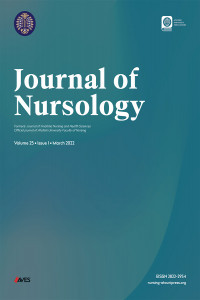EMZİRME EĞİTİMİNDE ÖĞRENDİĞİNİ ANLAT (TEACH-BACK) YÖNTEMİNİN KULLANIMI
emzirme, öğrendiğini anlat, sağlık eğitimi
Teach-Back Method Be Used in Breastfeeding
breastfeeding, teach-back, health education,
___
- AHRQ. (2017). Using the Teach-Back Technique: A Reference Guide for Health Care Providers.
- Aittasalo, M., Miilunpalo, S., Kukkonen-Harjula, K. ve Pasanen, M. (2006). A randomized intervention of physical activity promotion and patient self-monitoring in primary health care. Preventive Medicine, 42(1), 40-46.
- Atasay, B. ve Arsan, S. (2001). “ANNE VE YENİDOĞAN HAKLARI” BARSELONA DEKLARASYONU. Sürekli Tıp Eğitimi Dergisi, 10(12), 457-459.
- Badaczewski, A., Bauman, L. J., Blank, A. E., Dreyer, B., Abrams, M. A., Stein, R. E., . . . Sharif, I. (2017). Relationship between Teach-back and patient-centered communication in primary care pediatric encounters. Patient education and counseling, 100(7), 1345-1352.
- Dennis, C. L. E. (2006). Identifying predictors of breastfeeding self‐efficacy in the immediate postpartum period. Research in nursing & health, 29(4), 256-268. Farris, C. (2015). The teach back method. Home healthcare now, 33(6), 344-345.
- Ghiasvand, F., Riazi, H., Hajian, S., Kazemi, E. ve Firoozi, A. (2017). The effect of a self-care program based on the teach back method on the postpartum quality of life. Electronic physician, 9(4), 4180.
- Kılcı, H. (2014). Postpartum erken dönem emzirme başarısı ile postpartum geç dönem emzirme öz yeterlilik ve meme sorunları arasındaki ilişki. Adnan Menderes Üniversitesi, Sağlık Bilimleri Enstitüsü.
- Kountz, D. S. (2009). Strategies for improving low health literacy. Postgraduate medicine, 121(5), 171-177.
- Lerret, S. M. (2009). Discharge readiness: an integrative review focusing on discharge following pediatric hospitalization. Journal for Specialists in Pediatric Nursing, 14(4), 245-255.
- Tamura-Lis, W. (2013). Teach-back for quality education and patient safety. Urologic Nursing, 33(6), 267. Tarrant, R. C., Younger, K. M., Sheridan-Pereira, M. ve Kearney, J. M. (2011). Factors associated with duration of breastfeeding in Ireland: potential areas for improvement. Journal of Human Lactation, 27(3), 262-271.
- TNSA. ( 2013). Türkiye Nüfus ve Sağlık Araştırması. Hacettepe Üniversitesi Nüfus Etütleri Enstitüsü, 151. Turner, T., Cull, W. L., Bayldon, B., Klass, P., Sanders, L. M., Frintner, M. P., . . . Dreyer, B. (2009). Pediatricians and health literacy: descriptive results from a national survey. Pediatrics, 124(Supplement 3), S299-S305.
- Victora, C. G., Bahl, R., Barros, A. J., França, G. V., Horton, S., Krasevec, J., . . . Rollins, N. C. (2016). Breastfeeding in the 21st century: epidemiology, mechanisms, and lifelong effect. The Lancet, 387(10017), 475-490.
- Weiss, B. D. (2007). Health literacy and patient safety: help patients understand. Manual for clinicians: American Medical Association Foundation.
- White, M., Garbez, R., Carroll, M., Brinker, E. ve Howie-Esquivel, J. (2013). Is “teach-back” associated with knowledge retention and hospital readmission in hospitalized heart failure patients? Journal of Cardiovascular Nursing, 28(2), 137-146.
- WHO. (2017). Guideline: protecting, promoting and supporting breastfeeding in facilities providing maternity and newborn services.
- WHO ve UNICEF. (2003). Global strategy for infant and young child feeding: World Health Organization.
- Wilson, M. (2009). Readability and patient education materials used for low-income populations. Clinical Nurse Specialist, 23(1), 33-40.
- Başlangıç: 1998
- Yayıncı: Atatürk Üniversitesi
Mehmet KORKMAZ, İlknur AYDIN AVCİ
Şengül DOLU KUBİLAY, Seher ERGÜNEY
PİLONİDAL SİNÜS AMELİYATI SONRASI FARKLI YATIŞ POZİSYONUNUN DRENAJ MİKTARI ÜZERİNE ETKİSİ
Zeynep KARAMAN ÖZLÜ, Vesile ESKİCİ, İbrahim ÖZLÜ, Ayşegül YAYLA, Turgut ŞÖHRET, Meryem YAVUZ VAN GIERSBERGEN, Gamze KURT
EBELİK ÖĞRENCİLERİNİN DOĞUM AĞRISI VE YÖNETİMİ HAKKINDAKİ BİLGİ DÜZEYLERİNİN BELİRLENMESİ
Esra SARI, Gamze FIŞKIN, Sevda KARAKAŞ
Ecem ÇİÇEK GÜMÜŞ, Zeynep GÜNGÖRMÜŞ
İntörn Uygulamasının Öğrencilerin Hemşirelik Eğitiminden Aldıkları Doyuma Etkisi
Elanur YILMAZ KARABULUTLU, Gülcan BAHÇECİOĞLU TURAN, Fatma GÜNDÜZ ORUÇ
“AMELİYATHANE HEMŞİRESİ OLMAK”: NİTEL BİR ÇALIŞMA
Betül AKALIN, Ayşenur MODANLIOĞLU
TÜRKİYE’DEKİ TEZLERDE DOĞUM AĞRISININ YÖNETİMİNDE KULLANILAN NONFARMAKOLOJİK YÖNTEMLERİN İNCELENMESİ
Kemoterapi Alan Meme Kanseri Tanılı Hastaların Sorunları ve İhtiyacı Üzerine Niteliksel Bir Çalışma
